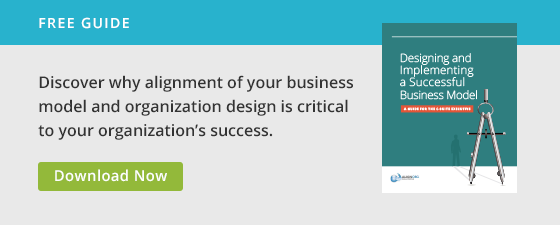Perhaps the simplest definition of a business model is an organization’s effort to deliver a unique solution to a customer need or problem. To improve your business model and organization, you need to ensure that all aspects of your organization align to solve your customers’ problem(s).
The best organizations today not only solve customer problems but also anticipate customer needs and wants before customers themselves are aware of them. Apple, for example, has repeatedly created innovative products that correctly anticipated customer needs. But since, competitors can quickly catch up to any new innovation, organizations like Apple achieve sustainable success by designing and aligning their organization to deliver consistently on the needs of their customers.
The obvious challenge in designing a successful business model is in both anticipating customer needs and designing your business model and organization to address those needs. Consider the following key questions as you reflect on how effectively your business model is delivering distinctive value to customers.
How do I learn what my customer really needs or wants? There are many traditional methods of obtaining data about customers such as surveys, focus groups, interviews, and secondary research. These methods are very effective and in the right situations can provide insights about customers that inform business models and organization designs. However, all of these methods suffer from a fatal flaw – what happens if the customer doesn’t really know what they want or need?
When customers can’t articulate or express what they need or want, organizations must have other methods for discovering those needs. Sometimes, direct observations of a potential customer’s activities will provide those insights. Some companies (particularly those developing apps) use a “test and learn” method of releasing a beta version of their app to see how customers use it and gather direct customer feedback. Over a period of time, refinements are made to the app until is it considered ready or out of beta testing. Sometimes at this point, the developer shifts from a free app to a for purchase app because they have discovered most of their customers needs and wants and have now met them.
How do I design my business model to give customers what they want? After you understand what the customer wants or needs, you must ensure that you can deliver those services or products in a distinctive way. This is as important or even more important than knowing what customers wanted in the first place! If you can’t deliver on customer wants, understanding them becomes of little relevance.
Unfortunately, many companies struggle to deliver because they fail to change how they operate or become focused on making things easy for those inside the organization. We had a client who set up a large standardized back office to facilitate customer/vendor billing. Although the support services were very efficient and met internal productivity requirements, they proved difficult for customers to navigate and ultimately drove customers away. The result was very happy internal users but frustrated external customers. Instead of structuring the organization to better deliver services to customers, the company was distracted by the internal operational ease.
To avoid this, ensure that your business model is a reflection of the key customer problem(s) you plan solve. Then, you must align your work activities, reward systems, metrics, culture, and structures to the strategy and business model. This alignment approach is not a quick shuffling of the organization chart, but it is a thoughtful (and in some cases, ongoing) effort to holistically align the entire organization and the related processes, systems, structures, metrics, rewards, and talent.
After you have aligned your organization to deliver what you think customers want or need, how do you know you are on the right track? What are the signals that you have found a powerful, compelling, distinctive business model or, conversely, that you need to go back to the drawing board?
- Bloomberg News is calling. What kind of attention are you getting in the media? Does the press reiterate the problem you were hoping to resolve for customers? Companies like Amazon, Apple, and Ryanair did and do a great job anticipating what customers wanted and the press noticed. Executives from these companies are sought after for interviews because there are listeners, viewers, and readers looking to find the secret to a great business model. If you listen closely, interviewers will ask questions to these people that virtually restates the original problem or need that the organization was trying to solve for its customers. Additionally, the number of positive mentions in social media will be very high.
- You attract the customers you want. A good business model is clear about who the target customer is. When you see your organization growing because you are adding your ideal, target customers, you know that you have correctly identified customer wants/needs and are delivering in a distinctive way.
- Better economic performance. If you are growing in the right way and are achieving better than average profits for your industry, you are headed in the right direction. It may seem over-simplistic, but when your business model is delivering and you have correctly identified customer wants/needs, you will have more customers, will sell more products and services, and will generate a loyal following.
- Customer loyalty. When customers have what they want, they are willing to overlook your faults and stick with you. The last few operating system launches for Apple’s Mac computers have been frustrating and bug-ridden, but because customers appreciate the simplicity, elegance, and ease-of-use of their suite of products and services, their customers largely stick with them.
To have success in today’s marketplace, you need to understand your target customers and solve their problem(s) by meeting in distinctive ways their wants/needs. While there are many ways to learn about your customers and anticipate their needs, all companies must align their organizations and business models. If companies combine customer understanding with organization alignment, they can achieve greater growth and profits, deeper customer loyalty, and better social media and press attention.






